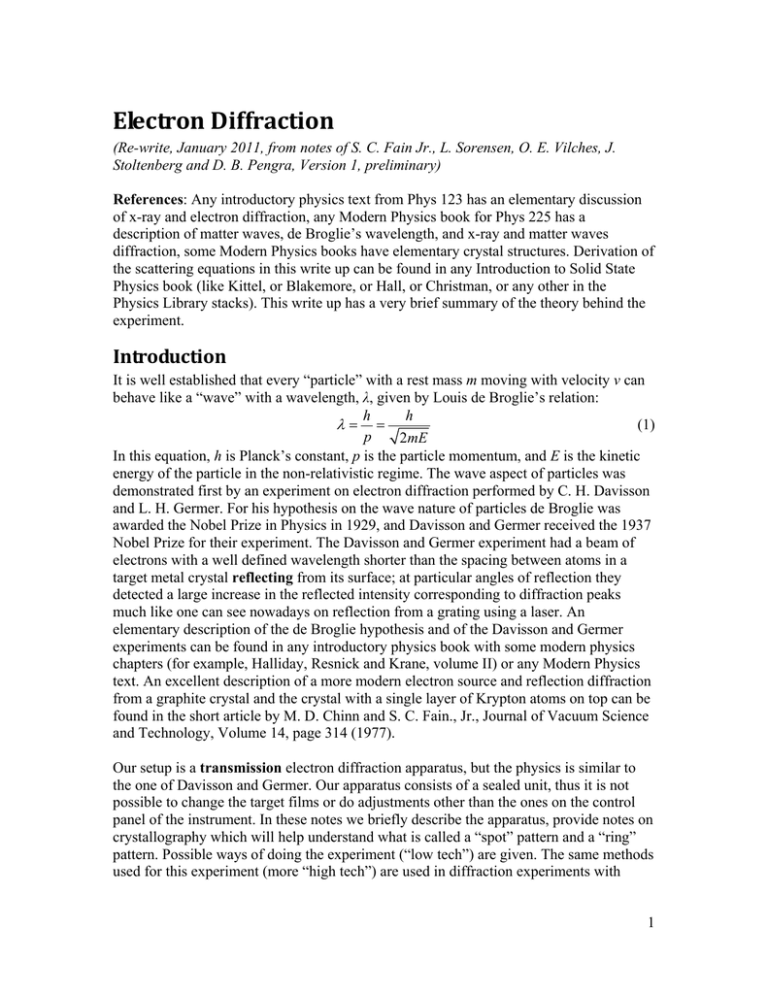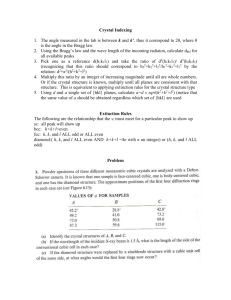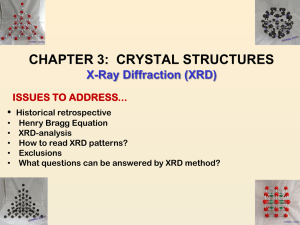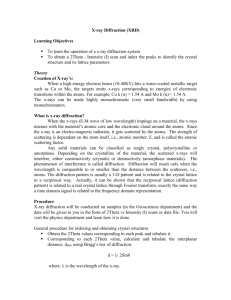Electron Diffraction
advertisement

ElectronDiffraction (Re-write, January 2011, from notes of S. C. Fain Jr., L. Sorensen, O. E. Vilches, J. Stoltenberg and D. B. Pengra, Version 1, preliminary) References: Any introductory physics text from Phys 123 has an elementary discussion of x-ray and electron diffraction, any Modern Physics book for Phys 225 has a description of matter waves, de Broglie’s wavelength, and x-ray and matter waves diffraction, some Modern Physics books have elementary crystal structures. Derivation of the scattering equations in this write up can be found in any Introduction to Solid State Physics book (like Kittel, or Blakemore, or Hall, or Christman, or any other in the Physics Library stacks). This write up has a very brief summary of the theory behind the experiment. Introduction It is well established that every “particle” with a rest mass m moving with velocity v can behave like a “wave” with a wavelength, λ, given by Louis de Broglie’s relation: h h (1) p 2mE In this equation, h is Planck’s constant, p is the particle momentum, and E is the kinetic energy of the particle in the non-relativistic regime. The wave aspect of particles was demonstrated first by an experiment on electron diffraction performed by C. H. Davisson and L. H. Germer. For his hypothesis on the wave nature of particles de Broglie was awarded the Nobel Prize in Physics in 1929, and Davisson and Germer received the 1937 Nobel Prize for their experiment. The Davisson and Germer experiment had a beam of electrons with a well defined wavelength shorter than the spacing between atoms in a target metal crystal reflecting from its surface; at particular angles of reflection they detected a large increase in the reflected intensity corresponding to diffraction peaks much like one can see nowadays on reflection from a grating using a laser. An elementary description of the de Broglie hypothesis and of the Davisson and Germer experiments can be found in any introductory physics book with some modern physics chapters (for example, Halliday, Resnick and Krane, volume II) or any Modern Physics text. An excellent description of a more modern electron source and reflection diffraction from a graphite crystal and the crystal with a single layer of Krypton atoms on top can be found in the short article by M. D. Chinn and S. C. Fain., Jr., Journal of Vacuum Science and Technology, Volume 14, page 314 (1977). Our setup is a transmission electron diffraction apparatus, but the physics is similar to the one of Davisson and Germer. Our apparatus consists of a sealed unit, thus it is not possible to change the target films or do adjustments other than the ones on the control panel of the instrument. In these notes we briefly describe the apparatus, provide notes on crystallography which will help understand what is called a “spot” pattern and a “ring” pattern. Possible ways of doing the experiment (“low tech”) are given. The same methods used for this experiment (more “high tech”) are used in diffraction experiments with 1 protons, positrons, x-rays, light, microwaves, neutrons and atoms (everything with a wavelength shorter than the distance between the “slits” of the diffraction grating). Apparatus The apparatus consists of an electron gun, similar to the ones used in “old” oscilloscopes except that the voltage (V) accelerating the electrons (charge e) can be varied between zero and about 10 kilovolts. The accelerating voltage controls the kinetic energy of the electrons emitted from a heated filament (essentially at rest compared to their final velocity). The final energy of the electrons (or their momentum) can be found from p2 E (2) eV 12 mv 2 2m Fig. 1. Schematic of apparatus. Notice that the scattering angle is 2θhkl, not θhkl as used in linear diffraction gratings in optics. The sample grid is much smaller in dimension than what it looks like in the cartoon. See text for explanation of Bragg diffraction. Fig. 1 shows a schematic of the apparatus inside the glass tube, see Fig. 2 below. Electrons can be accelerated, focused, and deflected horizontally and vertically so they pass through metal or graphite films mounted on a grid. The electrons eventually strike the fluorescent screen. If the sample has an aligned single crystal usually one can obtain diffraction “spots” on the screen, while if the sample is polycrystalline one usually gets “rings” on the screen. In Halliday, Resnick, Krane’s book there is a nice picture of“rings” obtained from an aluminum sample. In our apparatus it is good to follow these steps: turn the apparatus on, lower the intensity to zero (counterclockwise), set some accelerating voltage to about ¾ of the maximum (clockwise), look at the four quadrants (see Figure 2) where the samples are mounted, increase the intensity a little bit, and observe either spots, a mixture of spots and rings, or pure rings. After this initial setup and observation one can then proceed with the strategy for the experiment. Always use the minimum intensity needed to make observations. 2 Fig. 2. Free hand drawing of experimental box. The drawing of the four quadrants where films are mounted, although done over 30 years ago, still is reasonably accurate. A digital voltmeter will be added to the setup for better reading of the voltage, but use the analog meter in the unit while setting up. Crystals A three-dimensional crystalline solid is a periodic array of atoms (or molecules) in all three directions of space. For example, if we assume the usual x, y, z rectangular coordinates and there is one atom at every point of space with coordinates (ba, ca, da) with b, c, d all possible integers and a the shortest distance between two atoms, the simplest array of atoms (or “unit cells”) is one in which there is one atom at every corner of a cube, and the cubes stack neatly in all directions forming a three dimensional lattice, see Figure 3(a). The atoms don’t have to be at the corners of the cube though, but the cube is the smallest possible unit that will repeat itself an infinite number of times in all directions and if the appropriate size it will contain one atom per cube. This simplest unit cell is called a primitive cell and the lattice a simple cubic (sc) one. There is a total of 32 different crystalline structures in three dimensions, with a, b, c equal or not equal, and with rectangular and non-rectangular coordinates. The simple cubic arrangement of atoms is not common in nature. Two common arrangements are called face centered cubic (fcc) and hexagonal close packed (hcp), which are formed when atoms pack first in planes forming a “triangular” lattice, then these triangular lattice planes stack on top of each other, with atoms in the top layer into the hollows formed by three touching atoms of the under layer. If we call a packed plane by A, B, and/or C, if the planes are stacked on top of each other in the ABCABCA… sequence, the structure formed is fcc. In the fcc lattice the third over layer is back exactly on top of the first one (back to A). If they stack like ABABAB…the second over layer is stacked exactly on top of the first layer (back to A) and the structure is hcp, see Figures 3(b) and 3(c). 3 Fig. 3. Simple cubic, face centered cubic and hexagonal close packed lattices. A, B, and C in (b) and (c) refer to the order of stacking planes of packed atoms. The sc lattice is a primitive (P) lattice, the smallest unit cell that can be made. The primitive unit cell of the fcc lattice is rhombohedral and contains only one atom, but it is common to use the cubic cell shown, which contains four atoms. Many texts give unit cell size as the distance between two adjacent corners. The primitive unit cell of the hcp lattice has a rhombic base and the height from A to A in the picture. This smallest cell that can be translated to cover all space has two atoms in it. In total, there are 14 ways of arranging atoms in crystals, which are called the 14 Bravais lattices. A sketch of the 14 lattices is in Kittel’s book (Introductory Solid State Physics) and in Blakemore (Solid State Physics) and probably in most solid state physics books. BraggDiffraction When radiation (electrons, x-rays, neutrons, etc…) strikes a substance, some goes through and some scatters with different scattering cross sections. Some of the radiation gets absorbed. Electrons and x-rays interact with the electronic cloud of the atoms, and neutrons with the nucleus of atoms. Each type of radiation penetrates into substances in different ranges, electrons in general are very sensitive to atoms on the surface or are used to study very thin films (strong Coulomb interaction), x-rays penetrate considerably more and the cross section increases with atomic number (more electrons), neutrons can go through rather thick samples since they have no charge and the nucleus of an atom is very small, but neutrons are sensitive to different isotopes and to whether the nucleus has spin or not (they are very good to scatter from deuterium and hydrogen, which have different neutron scattering cross sections). If the scattering substance is crystalline, then it is possible that the crystal acts as a three-dimensional diffraction grating (or twodimensional, or one-dimensional depending on how many dimensions the crystal has) provided that the wavelength of the radiation/particles is smaller than the atom-atom spacing. To calculate properly the intensity of a refracted beam one should use each atom or molecule in the crystal as a scattering point or cloud for the particular radiation involved, and sum the scattered wave in all directions of space to find out where the diffracted intensity is strongest. In 1912, W. L Bragg proposed that the elastic scattering of x-rays from a crystal could be easily analyzed if we consider that through any perfect crystalline structure we can always draw families of parallel planes equidistant from each other, each 4 family containing all the atoms of the crystal. For example, if one looks at Fig. 3(b) and imagine a crystal with many units like the one pictured, the A, B, and C planes are parallel to each other, each containing the same number of atoms, separated by a distance dhkl between adjacent planes. For every crystalline structure there is an infinite number of different families of planes with different dhkl spacing between them. If every plane acts like a mirror, Bragg’s equation for finding the angle of strongest scattering (or perfect diffraction) is 2d hkl sin hkl n (3) The index n, an integer from 1 up to some maximum, is called the “order” of the diffraction peak. We usually analyze the first order peaks. The cartoon below, Fig. 4, shows the angles and distances in this equation. Each family of planes has a specific set of indices, called Miller indices. The planes shown in Fig. 3(b) have indices h=1, k=1, l=1, usually indicated (1 1 1). Miller indices are integers specifying the length of vectors in what is called reciprocal space, or “wavevector space”, which has dimensions of inverse distance. A full explanation is in the solid state physics books mentioned, too long to include here. Fig. 4 we show an incident beam of radiation of wavelength λ, scattered or transmitted from a family of parallel planes separated by dhkl. The reflected radiation is shown by 1, 2, and the transmitted radiation by 1a and 2a. The angle of incidence on a particular family of planes is θhkl, measured with respect to the planes (not the normal to the planes like in optical gratings). There is a reflected beam at angle 2θhkl with respect to the family of planes, and a transmitted beam also at angle 2θhkl if there is not strong attenuation or index of refraction changes. With the construction of Fig. 4 it is easy to derive Bragg’s law. Fig. 4. Bragg reflection. When the path difference between rays 1 and 2 (or 1a and 2a) is λ or a multiple of λ there is constructive interference at that specific angle. There is a very large number of parallel equidistant planes in a macroscopic crystal (thousands), thus at the angle of constructive interference there is in-phase addition of wave amplitudes and the intensity is proportional to the square of the amplitude. If the angle is not “perfect” then there is almost complete cancellation of the amplitude due to phase differences between rays and the intensity is practically zero. There is another reason why the intensity may be zero in a particular direction, even if Bragg’s equation says that the interference should be constructive: the placement of atoms in the crystal plane is important, thus there may be crystal structures in which the reflected intensity 5 from atoms in one plane may be 180o out of phase with the one of the next parallel plane. If this occurs, then intensity in that specific direction is zero. This leads to atomic and lattice form factors and allowed and disallowed Miller indices when identifying a diffraction pattern. TheBraggequationusingMillerindexesandourelectron diffractionapparatus The samples in the four quadrants of the sample holder shown in Fig. 2 are either graphite or a metal. Graphite crystallizes in a structure that resembles Fig. 3(c) with important differences, see Fig. 5: it does not have all of the close packed atoms in each crystal plane A (or B), the carbon atoms tied together with covalent bonds forming hexagons (missing the center atom of Fig 3(c)). Also the c-axis (vertical in Fig. 3(c)) is much longer on graphite than for a close packed structure since the bonding between the A and B layers is due to van der Waals forces (fluctuating electric dipoles). The strong cohesion in the A (or B) planes and the very weak cohesion between planes A and B is what makes graphite so good as a lubricant and the reason why one can fabricate nowadays one atomic layer carbon films (called graphene). Fig. 5. Top view of a graphite crystal. The crystal is formed by stacked layers of carbon. The carbon atoms are attached to other carbon atoms in the layer by covalent bonds in a hexagonal pattern, in picture above the top layer is the one with the hexagons with “dots” at each corner of the hexagon. Notice how tight the covalent packing is, and that the atom at the center of the hexagons is missing. In the vertical direction, perpendicular to the basal plane, another layer of hexagons is formed, shifted in such a way that there is a carbon atom at the center of each hexagon of the top layer. The next layer down is at the same position than the top layer. The arrows and heavy lines indicate a possible crystal “unit cell”, with a an b axis in the basal plane, and a c axis perpendicular to the basal plane through the origin which goes from the top layer to two layers above (ABABAB.. stacking of planes) For graphite, the scattering we observe is from the basal plane atoms and Bragg’s equation takes the form h 2 hk k 2 2 2 sin hk (4) 3a 2 where a is the magnitude of the unit cell base, 2.46 Å = 0.246 nm, formed by the equal length “real space” vectors a and b. One can complete the three-dimensional unit cell by drawing a vector c perpendicular the plane of a and b, such that its length c is the repeat 6 distance of the A planes. This cell is orthorhombic, with four carbon atoms per unit cell (can you draw the rest of the unit cell and check that there are four atoms in the cell?). All integer h and k are allowed values, with the index l = 0. For cubic structures, Bragg’s equation takes the form h2 k 2 l 2 2 2 (5) sin hkl 4a 2 Here a is the side of the cube, and there are specific rules due to phase cancellation for scattering from some planes: for sc lattices, h, k, and l can be any integer from 1 up until sin θhkl exceeds one, for fcc lattices the (h k l) integers must be either all odd or all even, and for the bcc lattices all integers are possible but their sum must be even. The number zero is an even integer: for example if one finds a particular scattering corresponding to indexes (1 1 0) the structure is not fcc (two odd and one even integer) but could be sc (all integers allowed) or bcc (the sum of the integers is even). When analyzing a diffraction spectrum on the screen of the oscilloscope (or a more sophisticate recording scheme) one must use several spots or rings at different distances to the center spot to decide which crystal structure it is. The two equations above can be derived from Bragg’s equation with a little bit of trigonometry. You can try it for the simple cubic lattice: draw a cube, put x, y, z axis on it, draw two parallel planes, one intersecting the three axis at distances a from the origin, and the second one parallel to it either through the origin or trough the cube corner opposite to the origin. Calculate the distance between the two planes as a function of a using trigonometry. Compare to Bragg’s law in the form of Eqn. 5. What Miller indexes do your planes have? TheExperiment In our experiment the graphite sample is mostly oriented, thus with “some work” one can obtain one or two superimposed sets of diffraction “spots” which clearly show the hexagonal symmetry of the pattern. The metal film samples, thin enough for the beam of electrons to go through, shows what is called a “ring pattern”. This ring pattern is due to micrometer size crystals next to each other, randomly aligned to form the film which is attached to the metal grid. For these samples here is complete randomness of orientation along the axis of the apparatus, and the films are thick enough that for each random orientation there will be a few crystals aligned “right” to satisfy Bragg’s condition (Eqns. 3, 4, 5). Thus the superposition of spots patterns produces the “rings” we observe. Figure 6 has another cartoon of “spots” from a graphite pattern single crystal, that when randomly oriented and superimposed along the axis of the apparatus generate a “ring” pattern. You can check in the figure that the “rings” you see correspond to the hk numbers allowed for these structure. Part 1. Use a “plastic” sheet taped over the fluorescent screen of the apparatus to study the relationship between the voltage measured by the voltmeter (digital and/or analog) and the diameter of one of the “spots” or “rings” of the graphite pattern. You can draw on the plastic sheet the chosen spot and the center of the pattern with the pen by the setup. Choose a clear spot or ring in the 4th or 5th diameters (of “rings”) and measure the 7 distance D between the center of ring pattern and the spot as a function of the voltage read by the voltmeters. Make a table of D vs. V. You should be able to convert D into the angle θhkl given that the distance L between the graphite film and the screen is (given by manufacturer) 18.06 cm. Ask yourself: am I measuring θhkl or 2θhkl? Am I measuring the sine or the tangent of the angle? Calculate λ as a function of V using the proper Miller indexes for the spot or ring you chose. Draw a graph of λ2 vs 1/V and calculate its slope (should it go through zero?). The slope of this graph should give a relationship between fundamental constants… is your measurement right? Calculate possible sources of error and make a reasonable estimate of them. COMMENT: if you are “orders of magnitude” off, check with instructors! This experiment works well, with some care, to the 5% level. Part 2. The object of Part 2 is to determine the type of structure of the metal film or films (sc, fcc or bcc) using the information from Part 1. It is better to do a good measurement on one of the three quadrants than a set of poor measurements on the three quadrants, but if you have time you can go back and do the three quadrants or leave it for a tedious but useful project at the end of the quarter! Find a good “ring” pattern for a given V, focus and intensity. Record your voltage, which will give you the wavelength using the data of Part 1. Make sure you have at least five “rings”. Tape a transparent sheet on the screen as in Part 1. Draw enough information on the plastic sheet to be able to measure the diameter of the rings. Convert the diameters to angles as done in Part 1. From this data, calculate a, the side of the cube, from Equation 5 above. Find a way to decide if the structure is sc, fcc or bcc, within the uncertainty of your measurement. Identify the metal! Common metals for evaporated films are copper, aluminum, gold and silver. Fig. 6. Spot pattern for a two-dimensional graphite crystal. If the target is composed of many parallel crystals but randomly oriented with respect to an axis through the center of the pattern (non-deflected beam direction) then the different spot patterns superimpose and one gets a “ring” pattern. 8







